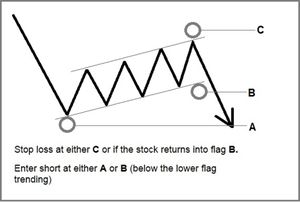Bear flag
| Bear flag |
|---|
| See also |
A Bear Flag is one of the chart patterns in the stock market. It is a clear, strong decline in volume in the case of negative fundamental development, several days of deviation from higher share prices in a much weaker volume, followed by a second, sharp decline to new minima in a strong volume.
The technical objective of the Bear Flag pattern comes from subtracting the height of the flag pole from the possible level of break-out at the point[1].
A bear flag appears when a trend is dominant. We therefore hope that time will fall and break short term flag support. However, our trading has become active. Short-term support can be either the lowest trend point or the lower trend line[2].
Flag designs and consolidations
Flag patterns are among the most powerful chart patterns in the stock market world. Not only do they provide a good signal, but, more importantly, they give us the opportunity to construct a simple and effective trading plan. This combination makes them so powerful. Flags can be further distinguished by pennants, triangles and wedges. For our purposes, let's call them all flags or strict consolidations. The point is that we only trade them when they break out of their strict consolidation towards the dominant trend[3].
Ideal Bear Flag
With the Bear Flags we want the consolidation to be either sideways or slightly drifting upwards in relation to the main trend. This gives us a support area that we can use to define our short entry point. If the consolidation drifts down in line with the main trend, it is impossible to define an entry point based on a support interruption. It is therefore essential to consolidate sideways or slightly in the direction of the dominant trend[4].
Difference between Bull Flag and Bear Flag
Typically, a Bull Flag is formed when the price falls and forms the shape of a standing cup as shown at the bottom of the chart below, and the three flags where they are shown above the fixed price action in the bearish The Hague pattern are practically mirrored against the Bull Flag pattern in the way it is generated. The bull's pattern is very similar to that of a cup standing upside down on the right, while the Bear Flag has the upside down pattern of a cup. The cup-shaped pattern at the bottom of the graph is the Bull Flag pattern. Both of these patterns because they differ slightly in the way they are generated and are not always as clear as shown here[5].
Footnotes
References
- Bruce M. Kamichi M. (2010) Chart Patterns, Bloomerg Press, New York
- Cohen G. (2012) The Insider Edge: How to Follow the Insiders for Windfall Profits, s. 33
- Flags and Pennants, (2019), s. 4
- Morales G. A. (2015) Short Selling with the O'Neil Disciples: Turn to the Dark Side of Trading, Wiley
- Tarr I. (2014) Stock Market Trading for Beginners, Authorhouse, Bloomington, USA
Author: Anna Syjud
